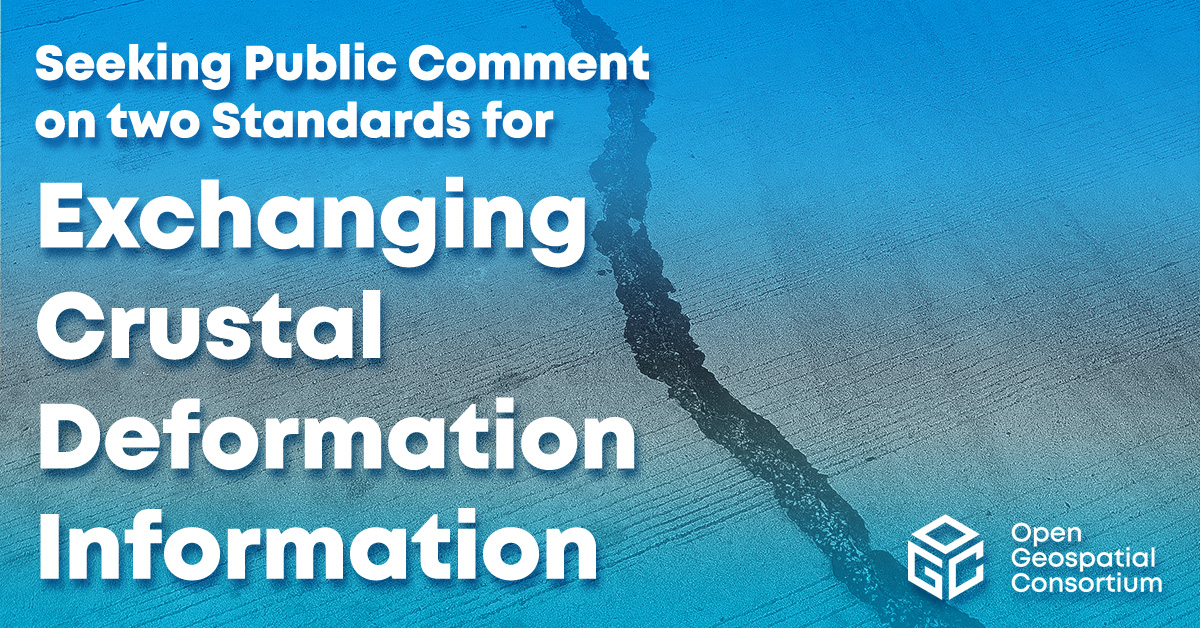Request Closed: April 19, 2023 9:00 am — May 19, 2023 11:59 pm (AoE)
The Open Geospatial Consortium (OGC) is requesting public comment on the candidate Deformation Model Functional Model Abstract Specification Topic and the Geodetic data Grid eXchange Format (GGXF) Standard. Comments are due by May 19, 2023.
These two Standards seek to improve the accuracy and exchange of coordinate references. The Deformation Model Functional Model is a conceptual model proposed as an OGC Abstract Specification Topic to standardize how deformation of the Earth’s surface can be consistently described. The Deformation Model Functional Model leverages the Geodetic data Grid eXchange Format (GGXF), a standardized means to describe regularly gridded geodetic information. GGXF also supports many other geodetic data types, particularly gridded data, supporting transformation of coordinates. Each of these candidate Standards are further described below.
Deformation Model Functional Model:
The surface of the Earth is moving. “Fixed” objects, such as buildings, are moving with the Earth’s crust and subject to ongoing plate tectonic movement as well as episodic deformation events like earthquakes. The ubiquitous movement of objects on Earth results in the coordinates of these features changing over time. This creates a challenge for the geospatial and positioning community: how can we account for this movement when comparing spatial datasets observed at different times? Similarly, how can we accurately locate an object whose coordinates were observed in the past?
One solution to this challenge is to use a deformation model: a mathematical model of the deformation of the crust over time. It allows the coordinates of a fixed object to be propagated to different times so that they track the object’s changing coordinates.
Common uses of a deformation model include:
- determining the current location of an object based on an earlier measurement of its location;
- transformation of the current observed location of an object to the reference epoch of a static CRS;
- determining the spatial relationship of datasets observed at different times; or
- predicting the location of an object at some future time.
Currently, many national geodetic agencies have constructed, or are planning for, deformation models. Currently however, these models commonly use customized formats and are typically used only in software developed by the agency.
The draft OGC Deformation Model Functional Model is a standard framework for describing deformation. It describes a way of parameterizing deformation such that it can be encoded into a spatial dataset and incorporated into software for use in coordinate operations. It also defines how to calculate the displacement of a point between two different epochs (times). The specification will allow producers of deformation models, such as national geodetic agencies, to publish these models in a consistent way. This consistency means that users of software that performs coordinate operations, such as coordinate transformations, can be confident that the model is being applied as intended by the producers.
The Geodetic data Grid eXchange Format (GGXF):
The Geodetic data Grid eXchange Format (GGXF) is designed to be a single file format that may be used for a wide range of geodetic applications requiring interpolation of regularly gridded data, including (but not limited to):
- Transformation of latitude and longitude coordinates from one geodetic CRS to another;
- Transformation of gravity-related heights from one vertical CRS to another;
- Reduction of ellipsoid heights to the geoid, quasi-geoid or the reference surface of a vertical coordinate reference system; or
- The description of coordinate changes due to deformation.
The GGXF format has been designed specifically for carrying gridded geodetic parameters supporting coordinate transformations and point motion operations but has no restriction on the type of content that may be included.
A single, standard, grid file format offers the following advantages:
- Grid producers do not have to create file formats themselves, provide their own software to read and interpolate their gridded data, or concern themselves with lack of take-up of their data due to its proprietary distribution format;
- Survey and geographic information software vendors need to read only one grid file format, eliminating the need to repeatedly write programs to import different grids;
- End users can use a new grid file as soon as it becomes available, without having to wait for their application vendor to produce a software upgrade.
GGXF has been designed to cope with multiple levels of data resolution, engender computational efficiency, be straightforward for grid producers to populate, and easy and efficient for application developers to use.
OGC Members interested in staying up to date on the progress of this standard, or contributing to its development, are encouraged to join the CRS SWG via the OGC Portal.
The candidate Deformation Model Functional Model Abstract Specification Topic (22-010) (.PDF) and the candidate Geodetic data Grid eXchange Format (GGXF) Standard (22-051r2) (.PDF) are available for review and comment on the OGC Portal. Comments are due by May 19, 2023, and should be submitted via the method outlined below.
To Comment:
Comments can be submitted to a dedicated email reflector for a period ending on the “Close request date” listed above. Comments received will be consolidated and reviewed by OGC members for incorporation into the document. Please submit your comments via this email address, using this Comments Template for the message body.
Subscribe to Comments:
You may wish to subscribe to the distribution list to receive comments as they are submitted. Subscribing to the list will also allow you to view comments already received, which can be found in the List Archives.
